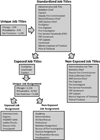Creation of a retrospective job-exposure matrix using surrogate measures of exposure for a cohort of US career firefighters from San Francisco, Chicago and Philadelphia
- PMID: 26163543
- PMCID: PMC4576837
- DOI: 10.1136/oemed-2014-102790
Creation of a retrospective job-exposure matrix using surrogate measures of exposure for a cohort of US career firefighters from San Francisco, Chicago and Philadelphia
Abstract
Objectives: To construct a cohort-specific job-exposure matrix (JEM) using surrogate metrics of exposure for a cancer study on career firefighters from the Chicago, Philadelphia and San Francisco Fire Departments.
Methods: Departmental work history records, along with data on historical annual fire-runs and hours, were collected from 1950 to 2009 and coded into separate databases. These data were used to create a JEM based on standardised job titles and fire apparatus assignments using several surrogate exposure metrics to estimate firefighters' exposure to the combustion byproducts of fire. The metrics included duration of exposure (cumulative time with a standardised exposed job title and assignment), fire-runs (cumulative events of potential fire exposure) and time at fire (cumulative hours of potential fire exposure).
Results: The JEM consisted of 2298 unique job titles alongside 16,174 fire apparatus assignments from the three departments, which were collapsed into 15 standardised job titles and 15 standardised job assignments. Correlations were found between fire-runs and time at fires (Pearson coefficient=0.92), duration of exposure and time at fires (Pearson coefficient=0.85), and duration of exposure and fire-runs (Pearson coefficient=0.82). Total misclassification rates were found to be between 16-30% when using duration of employment as an exposure surrogate, which has been traditionally used in most epidemiological studies, compared with using the duration of exposure surrogate metric.
Conclusions: The constructed JEM successfully differentiated firefighters based on gradient levels of potential exposure to the combustion byproducts of fire using multiple surrogate exposure metrics.
Keywords: Dose-Response; Firefighters; Job-Exposure Matrix.
Published by the BMJ Publishing Group Limited. For permission to use (where not already granted under a licence) please go to http://group.bmj.com/group/rights-licensing/permissions.
Figures




Similar articles
-
Mortality in a cohort of US firefighters from San Francisco, Chicago and Philadelphia: an update.Occup Environ Med. 2020 Feb;77(2):84-93. doi: 10.1136/oemed-2019-105962. Epub 2020 Jan 2. Occup Environ Med. 2020. PMID: 31896615 Free PMC article.
-
Exposure-response relationships for select cancer and non-cancer health outcomes in a cohort of U.S. firefighters from San Francisco, Chicago and Philadelphia (1950-2009).Occup Environ Med. 2015 Oct;72(10):699-706. doi: 10.1136/oemed-2014-102671. Epub 2015 Feb 11. Occup Environ Med. 2015. PMID: 25673342 Free PMC article.
-
Development of a job-exposure matrix (JEM) for exposure to smoke particle mass among firefighters of the Fire Department of the City of New York (FDNY).Occup Environ Med. 2023 Feb;80(2):104-110. doi: 10.1136/oemed-2022-108549. Epub 2023 Jan 12. Occup Environ Med. 2023. PMID: 36635097
-
[Cancer risk in firefighters].Rev Med Chil. 2023 Jul;151(7):929-933. doi: 10.4067/s0034-98872023000700929. Rev Med Chil. 2023. PMID: 39093182 Review. Spanish.
-
Firefighters' Clothing Contamination in Fires of Electric Vehicle Batteries and Photovoltaic Modules-Literature Review and Pilot Tests Results.Int J Environ Res Public Health. 2022 Sep 29;19(19):12442. doi: 10.3390/ijerph191912442. Int J Environ Res Public Health. 2022. PMID: 36231742 Free PMC article. Review.
Cited by
-
Mortality in a cohort of US firefighters from San Francisco, Chicago and Philadelphia: an update.Occup Environ Med. 2020 Feb;77(2):84-93. doi: 10.1136/oemed-2019-105962. Epub 2020 Jan 2. Occup Environ Med. 2020. PMID: 31896615 Free PMC article.
-
End-stage renal disease incidence in a cohort of US firefighters from San Francisco, Chicago, and Philadelphia.Am J Ind Med. 2022 Dec;65(12):975-984. doi: 10.1002/ajim.23435. Epub 2022 Oct 21. Am J Ind Med. 2022. PMID: 36268894 Free PMC article.
-
Assessment of Ambient Exposures Firefighters Encounter While at the Fire Station: An Exploratory Study.J Occup Environ Med. 2017 Oct;59(10):1017-1023. doi: 10.1097/JOM.0000000000001114. J Occup Environ Med. 2017. PMID: 28991807 Free PMC article.
-
Discovery of firefighter chemical exposures using military-style silicone dog tags.Environ Int. 2020 Sep;142:105818. doi: 10.1016/j.envint.2020.105818. Epub 2020 Jun 7. Environ Int. 2020. PMID: 32521346 Free PMC article.
-
Association of firefighting exposures with lung function using a novel job exposure matrix (JEM).Occup Environ Med. 2024 Feb 2;81(2):84-91. doi: 10.1136/oemed-2023-109155. Occup Environ Med. 2024. PMID: 38233128 Free PMC article.
References
-
- Heyer N, Weiss NS, Demers P, et al. Cohort mortality study of Seattle fire fighters: 1945–1983. Am J Ind Med. 1990;17:493–504. - PubMed
-
- Beaumont JJ, Chu GS, Jones JR, et al. An epidemiologic study of cancer and other causes of mortality in San Francisco firefighters. Am J Ind Med. 1991;19:357–372. - PubMed
-
- Guidotti TL. Mortality of urban firefighters in Alberta, 1927–1987. Am J Ind Med. 1993;23:921–940. - PubMed
-
- Aronson KJ, Tomlinson GA, Smith L. Mortality among fire fighters in metropolitan Toronto. Am J Ind Med. 1994;26:89–101. - PubMed
Publication types
MeSH terms
Grants and funding
LinkOut - more resources
Full Text Sources
Other Literature Sources
Medical
